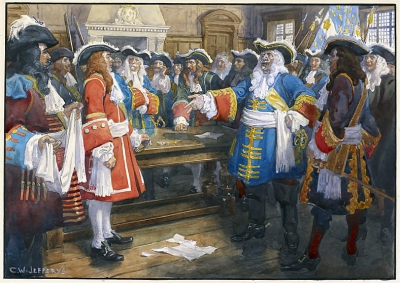William III (William Henry; Dutch: Willem Hendrik; 4 November 1650 8 March 1702), also widely known as William of Orange, was the sovereign Prince of Orange from birth, Stadtholder of Holland, Zeeland, Utrecht, Guelders, and Overijssel in the Dutch Republic from the 1670s, and King of England, Ireland, and Scotland from 1689 until his death in 1702. As King of Scotland, he is known as William II. He is sometimes informally known as "King Billy" in Ireland and Scotland. His victory at the Battle of the Boyne in 1690 is commemorated by Unionists, who display orange colours in his honour. He ruled Britain alongside his wife and cousin Queen Mary II, and popular histories usually refer to their reign as that of "William and Mary".
William was the only child of William II, Prince of Orange, and Mary, Princess Royal, the daughter of Charles I of England, Scotland, and Ireland. His father died a week before his birth, making William III the Prince of Orange from birth. In 1677, he married Mary, the eldest daughter of his maternal uncle James, Duke of York, the younger brother of Charles II of England, Scotland, and Ireland. The Protestant William participated in several wars against the powerful Catholic French ruler Louis XIV in coalition with both Protestant and Catholic powers in Europe. Many Protestants heralded William as a champion of their faith. In 1685, his Catholic uncle and father-in-law, James, became king of England, Scotland, and Ireland. James's reign was unpopular with the Protestant majority in Britain, who feared a revival of Catholicism. Supported by a group of influential British political and religious leaders, William invaded England in what became known as the Glorious Revolution. In 1688, he landed at the south-western English port of Brixham; James was deposed shortly afterward.
William's reputation as a staunch Protestant enabled him and his wife to take power. During the early years of his reign, William was occupied abroad with the Nine Years' War (16881697), leaving Mary to govern Britain alone. She died in 1694. In 1696 the Jacobites, a faction loyal to the deposed James, plotted unsuccessfully to assassinate William and restore James to the throne. William's lack of children and the death in 1700 of his nephew Prince William, Duke of Gloucester, the son of his sister-in-law Anne, threatened the Protestant succession. The danger was averted by placing distant relatives, the Protestant Hanoverians, in line to the throne with the Act of Settlement 1701. Upon his death in 1702, the king was succeeded in Britain by Anne and as titular Prince of Orange by his cousin John William Friso, beginning the Second Stadtholderless period.
King William's War (also known as the Second Indian War, Father Baudoin's War, Castin's War, or the First Intercolonial War in French) was the North American theater of the Nine Years' War (1688–1697), also known as the War of the Grand Alliance or the War of the League of Augsburg. It was the first of six colonial wars (see the four French and Indian Wars, Father Rale's War and Father Le Loutre's War) fought between New France and New England along with their respective Native allies before France ceded its remaining mainland territories in North America east of the Mississippi River in 1763.
For King William's War, neither England nor France thought of weakening their position in Europe to support the war effort in North America. New France and the Wabanaki Confederacy were able to thwart New England expansion into Acadia, whose border New France defined as the Kennebec River in southern Maine.: 27 According to the terms of the 1697 Peace of Ryswick that ended the Nine Years' War, the boundaries and outposts of New France, New England, and New York remained substantially unchanged.
The war was largely caused by the fact that the treaties and agreements that were reached at the end of King Philip's War (1675–1678) were not adhered to. In addition, the English were alarmed that the Indians were receiving French or maybe Dutch aid. The Indians preyed on the English and their fears, by making it look as though they were with the French. The French were played as well, as they thought the Indians were working with the English. These occurrences, in addition to the fact that the English perceived the Indians as their subjects, despite the Indians' unwillingness to submit, eventually led to two conflicts, one of which was King William's War.

1689May, 12
King William's War: William III of England joins the League of Augsburg starting a war with France.
Choose Another Date
Events on 1689
- 18Apr
1689 Boston revolt
Bostonians rise up in rebellion against Sir Edmund Andros. - 20Apr
Siege of Derry
Deposed monarch James II of England lays siege to Derry. - 12May
William III of England
King William's War: William III of England joins the League of Augsburg starting a war with France. - 27Jul
Battle of Killiecrankie
Glorious Revolution: The Battle of Killiecrankie ends. - 5Aug
Lachine massacre
Beaver Wars: Fifteen hundred Iroquois attack Lachine in New France.

 English
English  español
español  français
français  português
português  русский
русский  العربية
العربية  简体中文
简体中文 